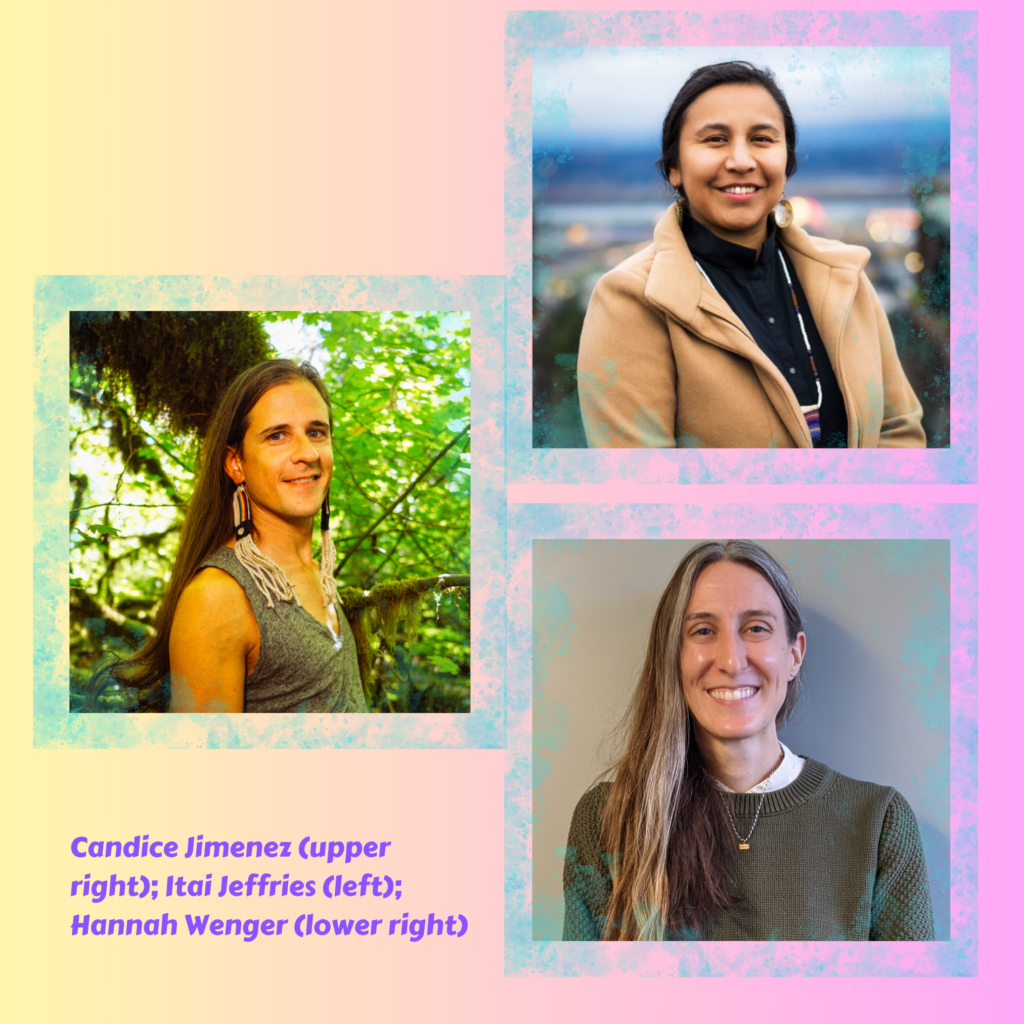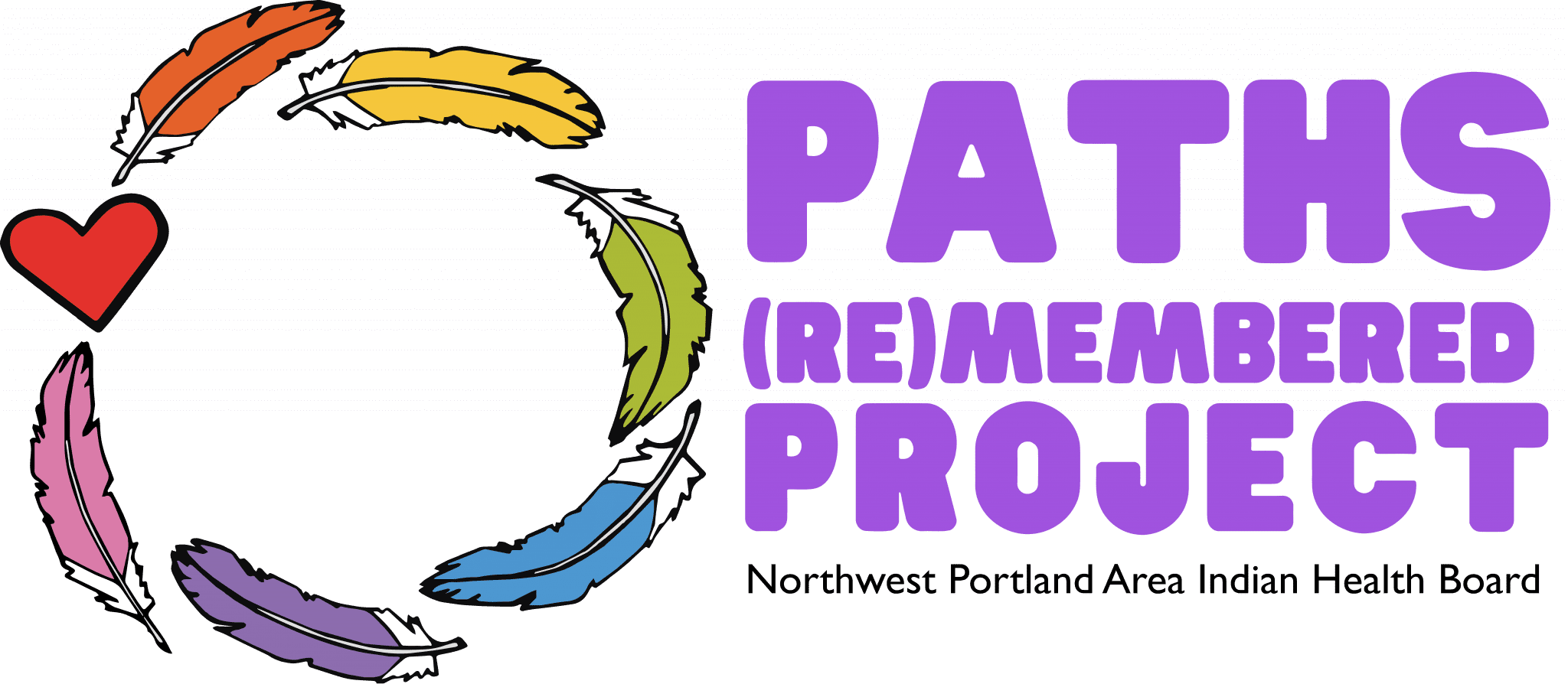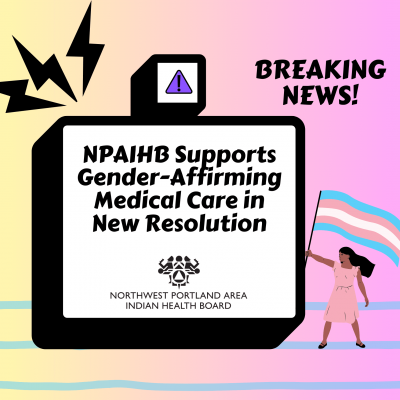On July 25, 2023, the Northwest Portland Area Indian Health Board (NPAIHB), a representative board of delegates from 43 Tribal Nations in Oregon, Idaho, and Washington, passed a resolution titled “Support for Delivery of Gender-Affirming Medical Care for Two Spirit, and AI/AN TGD Children, Youth, and Adults.” Within this resolution, NPAIHB states “that Tribal Nations have the inherent sovereignty to provide gender-affirming medical care to their patients, including Tribal citizens and Indian Health Service beneficiaries, at their Tribal health clinics or to refer any patient to a healthcare facility in a sanctuary state” and “calls on the President and the Administration…to recognize the inherent sovereign authority of Tribal Nations to provide gender-affirming medical care to their patients.”
For this month’s blog article, we sat down with Itai Jeffries, Candice Jimenez, and Hannah Wenger to discuss the creation of this resolution and its significance in this moment.
Could you introduce yourselves?
Sure. I’m Itai Jeffries. I lead the Paths (Re)membered Project at the Northwest Portland Area Indian Health Board, which is our Two Spirit health initiative. I’m Occaneechi from North Carolina, and my pronouns are they, them, and y’all.
I’m Candice Jimenez (she/her). I’m a tribal citizen of the Confederated Tribes of Warm Springs, and a chief of staff with the Northwest Portland Area Indian Health Board. I’m part of the policy team that helps support resolutions at the board including the one we’re discussing today.
My name is Hannah Wenger. I use she pronouns. I am a settler and primary care doctor who focuses on health care for Indigenous and non-Indigenous transgender people. I work as a physician consultant on gender-affirming care at the Northwest Portland Area Indian Health Board, and I’m one of the clinical faculty for the Trans and Gender-Affirming Care Indian Country ECHO. When I’m not working at the board, I work in academics doing gender-affirming care.
I’m curious, first, about the context in which this resolution was created. Why did it feel important to create this resolution in this moment?
Itai: I think the resolution first came up in response to a provider survey we’d sent out to clinicians who were a part of our Gender-Affirming ECHO. One of the things we noticed was that folks providing care within tribal clinics were uncertain of whether or not the Tribal Nations they were working within were supportive of that care. They were also unsure where Indian Country in general stood on the question of gender-affirming care. We knew there was a lot of support, but the support wasn’t visible. We first floated the idea of a resolution as a way of making that support visible to tribal members and to clinicians, so that clinicians could feel more confident providing the care they know their patients need. That kicked off the first conversation, and then we met with the policy team to really get things in order and write a draft of the resolution.
Candice: I’d add that this topic is a priority that providers and tribal leaders have reached out to the health policy team about, asking how to navigate in their own health programs. It’s really meaningful for them to know there’s support from tribal delegates of the Northwest Portland Area Indian Health Board in a collective capacity in the form of a resolution.
I’m curious, for folks who may not be familiar with the world of tribal policy—what is a resolution?
Candice: A resolution documents a set of decisions made by a group or organization like the Northwest Portland Area Indian Health Board, which is made up of the 43 tribal health delegates from the tribes of Oregon, Washington, and Idaho. A resolution affirms a decision from the health board and allows us to move that decision up into other spaces, to amplify it. So a resolution might start here in the northwest, with the health board, and then go into other spaces like the Affiliated Tribes of Northwest Indians (ATNI), the National Congress of American Indians (NCAI), and beyond. It helps us garner voices and gather a critical mass of support. So a resolution might start in the northwest, but many other voices can affirm and support the resolution as well.
What in your mind and heart is the significance of this specific resolution in support of gender-affirming care having been passed by the Northwest Portland Area Indian Health Board in this moment?
Candice: For me, it’s about people feeling safe and knowing they have community who support them. From their clinician to tribal health leaders to the person next to them accessing care. It’s about them feeling that they can walk into a healthcare setting and access the care they need without barriers. And for providers, too, to feel safe providing the care their patients need. And for clinical spaces to be able to offer medications or surgeries or other services that support every individual who walks through their doors.
Itai: One of the significant pieces of this resolution for me is that this is a recognition of sovereignty, that our tribal clinics, our Tribal Nations, have the right to do what it takes to meet the health needs, economic needs, and social needs of their communities and citizens. If you read the language of this resolution, it says that tribes in the Pacific Northwest and nationally have the ability to provide the health care that they see fit. We spell out gender-affirming care, because there are challenges to that care right now in various states. But to me, it’s really about the ability of tribes to provide any care that they determine that their people need. In that sense, this resolution is just a reminder of what we already know—that our trans, gender-diverse and queer community members are our people and have always been our people.
Hannah: I just want to echo all the things that have already been said, specifically the importance of safety for patients accessing care and for the people who provide that care. As someone who practices gender-affirming care, I think about my patients’ safety and my safety all the time. By safety, I mean emotional, psychological, and physical safety. Not every healthcare or community space is welcoming or open to my patients or to me and the work that I do. This resolution is personally very meaningful for me as a clinician who is dedicated to being in relationship with and providing health care to trans and gender-diverse people, especially people in Indian Country. It feels like a warm hug extended by Pacific Northwest tribes to the queer community and to healthcare providers like me, and I am so grateful to know that Indigenous trans and gender-diverse people are seen and actively supported and that healthcare providers now clearly know that these Tribal nations stand in support of gender-affirming care for their people. I also think this resolution is truly precedent setting within this country across all levels of government—federal, state, and tribal. I hope it sets a clear trajectory for the rest of Indian Country and for what states and the federal government can also do to see us, to stand with us, and to extend that warm hug to us. We need it in these times.
Given this precedent-setting resolution, what are your hopes and dreams for the future of the resolution?
Candice: Within the context of health policy, as I mentioned, we’ll go from here to ATNI and NCAI. We’ll also share this resolution out with IHS, with the Office of the Assistant Secretary for Health, with other agencies whom we interface with through tribal advisory committees, for example. All of these spaces—and all our policy work—is interconnected. As we go into these areas and talk about gender-affirming care, we’ll talk about how this is accepted and supported healthcare within our communities. There’s a lot of stories that we’ve heard—on the news, especially in the last year—about people not being able to access gender-affirming care. And there’s stories that we don’t hear on the news, too. I hope this resolution allows us to bring those realities forward into tribal leadership spaces more often and makes that care more accessible.
Hannah: When I interface with healthcare professionals who serve Native people, including in IHS, tribal, and urban Indian facilities, there’s often this question of: Where does the local tribe stand on this kind of care on their lands and in their healthcare facility? And where does the IHS stand? How does that relate to accessing and providing gender-affirming care at I/T/U facilities across the lifespan? So, having a resolution like this to share with clinical folks—both the people directly providing care and the people who run these healthcare facilities—is incredibly powerful. The resolution is made even more powerful by the existing bedrock of incredible work on gender-affirming care that has been ongoing for years at NPAIHB and in Indian Country. We need policies like this resolution. We also need the clinical care support like Indian Country ECHO and our Clinician Consult Warmline so healthcare providers at these Native healthcare facilities are empowered to provide this care to children, youth, and adults. We need the healthcare systems support like the gender-affirming care resource guide for I/T facilities so that the necessary infrastructures are in place for this care to be accessible directly at these facilities. Finally, we need data and knowledge-sharing in community like that cultivated by Itai and all these amazing folks at Paths (Re)Membered so we can understand the needs of and connect with Native people who are gender-diverse. The resolution is synergistic to this work in very real, tangible ways. To know that there’s affirmation and support of gender-affirming care within Indigenous spaces (in stark contrast to many non-Indigenous spaces in this moment) moves us so much closer to our goal of ensuring this care is readily accessible to Indigenous people.
Itai: I want to focus on two things. The first is personal. To see all the support nationally for really toxic and transphobic legislation…to witness that conversation as an Indigiqueer, non-binary, Two Spirit person in this work is incredibly challenging. I often feel like I don’t have the capacity for loss. A loss feels very personal. So to work for a board where not only staff are supportive, but where a whole board of delegates and leadership are championing this care—it’s probably the only route for me to be engaged in this work right now. I’ve had doubts about my ability to sustain myself in this work this year. This resolution really gave me a breath of fresh air.
Second, I want to speak about local and regional implications. When we go out and do site visits or meet with clinics or go out to community events and talk to youth and all kinds of folks across the community, I hear often that Two Spirit or Indigiqueer people aren’t sure about support in their own communities. Sometimes people say their safety plan as a queer or trans person involves getting out of their own community. To be able to say that this representative body, that these delegates have signed this resolution—that’s a strong message. And it gives people a reason to hold on for a little longer. It lets them know that something good is happening.
I’m looking forward to some upcoming workshops we have with youth at one of our local tribes here. I’m looking forward to letting them know about it and getting them excited about tribal leadership. Maybe they want to be the delegate on the board one day, maybe they want to run for council. I’m excited to share with them that they could pass legislation like this, to say, You could pass resolutions about issues you care about, to let our young people have these glimpses of hope, realize that things don’t have to be the way they are in their communities, to let them know they can be part of that change.
Candice: Yes. As Itai was talking, I was thinking too about the Northwest Native American Center of Excellence (NNACOE) and our next generation of clinicians and providers. I’m excited to see how we can share this out with those young people, with our future clinicians and the next generation of the health workforce. That’s another part of the big picture thinking—connecting with them, and sharing this with future clinicians. They are also a part of this.



